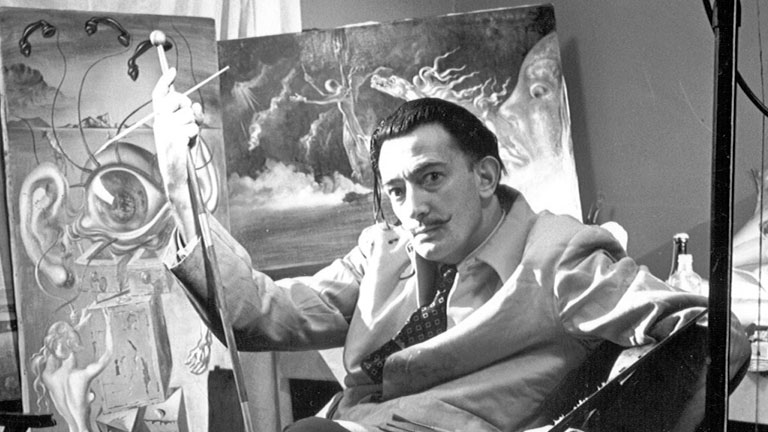SALVADOR DALÍ
Salvador Dalí (1904-1989) was perhaps the most publicized artist of the twentieth century. He is remembered for his surrealist art and outrageous personality. Dalí's paintings are his most celebrated works, but he was a versatile artist who also worked with film, jewelry, sculpture, literature, and graphic arts. Towards the end of his life, Dalí produced an enormous ouevre of prints-many of which were equal in brilliance and quality to his earlier works. However, many scholars and critics have scorned Dalí's graphic works because as he grew older he became less involved in the production process of his prints. He even signed large quantities of blank pages for his printing team to use. Because of the uncontrolled editions of his graphic works, Dalí has received negative attention for his reproduced art, despite its virtuosity and innovation.
One of Dalí's most incredible series of graphic works is an artist's book entitled Alchimie des Philosophes, or Alchemy of the Philosophers. Created in 1976, it contains ten prints encased in a large portfolio box with ancient alchemical texts from the 3rd-17th centuries reproduced in facsimile. The prints are 56 x 76 cm, and were created with a combination of intaglio, lithography, and serigraphy. There are 275 copies of Alchimie des Philosophes, some in French and English, and some in French and Italian. Each of the prints represents a particular alchemical theme and relates to the ancient texts. The iconography combines Dalí's personal motifs with the symbolism of thousands of years of alchemy.
ALCHEMY
Alchemy arose in many ancient cultures, each employing somewhat different theories. Dalí recognized the multi-faceted nature of alchemy and drew inspiration from Chinese, Greek, Arabic, Hebraic, and Western alchemy. Alchemy is notoriously mysterious and frequently misunderstood. The modern perception of alchemy is that it was practiced by greedy sorcerers attempting to create gold. While the creation of gold was certainly a component of alchemy, there was also a spiritual side. Just like alchemists wanted to purify base matter into gold, they also wanted to purify the human soul into a perfect being. Thus, alchemy has two distinct subdivisions: physical alchemy (laboratory experiments, the precursors of modern chemistry) and spiritual alchemy (philosophical teachings).
The ultimate goal of alchemy was purification. In physical alchemy, this manifested in a concrete product, the Philosopher's Stone. The Philosopher's Stone would ideally be a physical substance which provided eternal life and purity to the successful alchemist. In spiritual alchemy, the goal was a transmuted, perfect spirit which also gave the alchemist eternal life. Even though the two types of alchemy are fundamentally different, the symbolism remains the same. In order to protect their secrets, alchemists deliberately made their texts difficult to understand, with conflicting metaphors and symbols.
THE EXHIBITION
Each page of this online exhibition is dedicated to one of Dalí's prints in Alchimie des Philosophes. It includes an image and description of the print above a gallery of thumbnails. The first row of thumbnails includes closer details of each featured print. Below those are relevant images from alchemical texts, or other works by Dalí which use similar symbols. At the bottom of the pages are quotes from the alchemical texts that Dalí used as inspiration. There is also a Glossary which explains alchemical terms and symbols.
“All great art is born of alchemy and going beyond death. But I make gold by transcending my innards through hyperconsciousness."
-Salvador Dalí
